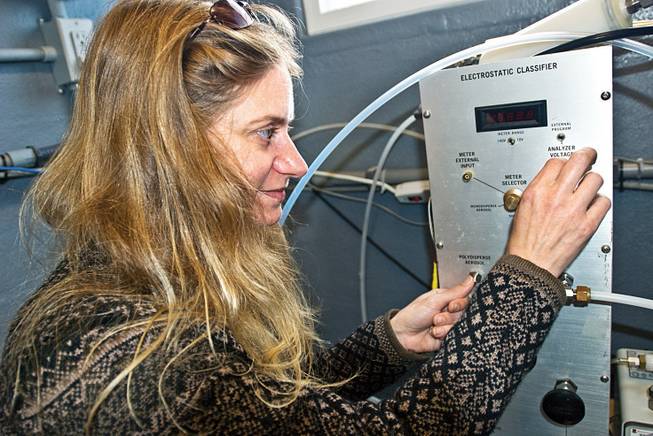
Robert Monroe / Scripps Institution of Oceanography
Atmospheric chemistry professor Lynn Russell maintains an airborne particle analysis facility at the end of Scripps Pier. Intake valves channel air samples to analyze the composition of airborne particles.
Tuesday, June 23, 2009 | 2 a.m.
Sun Archives
- Study: Las Vegas' leafy areas add to air pollution (6-18-2009)
- State eyes membership in cleanup compact (4-27-2005)
- LV ranked 18th in nation in smog days (9-23-2004)
Crazy drivers? They must be Californians. Inflated home prices? It’s those California investors. Bad air quality? Yup — and there’s a study to prove it: We get some of our smog from California.
Researchers have concluded that aerosols — fine droplets containing bits of dust, sea salt, soot from motor vehicles and burned wood, and even bacteria — have San Diego roots. And they get here following the same path most Californians take: Interstate 15.
These droplets contribute to ozone formation.
Lynn Russell, a professor of atmospheric chemistry, and her team at Scripps Institution of Oceanography at the University of California, San Diego, reached their conclusion after sampling air at a San Diego pier last year and then adding wind directions and speed into a computer model to determine where the airborne particles would end up.
They found that a carbon-based component found in industrial pollution and motor vehicle emissions, largely from diesel trucks, traveled in air currents from San Diego to Las Vegas.
In February and March there were periods when the aerosols followed
I-15 all the way to Las Vegas, probably because of the route’s topography and because the I-15 traffic contributed to the pollution stream.
“We were really surprised,” Russell said, adding that she and her team “did not expect to have such consistent winds.”
The yearlong study found the pattern most intense in February and March. Luckily for Las Vegas, those aren’t our hottest months, because this type of aerosol, when combined with heat, creates ozone, the air pollution that has been linked to myriad health problems, particularly respiratory illnesses.
The bad news, however, is that the pattern shows up all year, meaning Southern Nevadans can do everything humanly possible to reduce ozone here in the summer — and breathing here could still be difficult at times, because of Southern California.
Analysis of the I-15 data also suggests that when the wind reverses direction and blows from Nevada to Southern California, those aerosols can end up where they started. Some of the organic aerosols from human activity blow toward Las Vegas from San Bernardino and Riverside and then back toward San Diego as winds shift, Russell’s research indicated.
Because winds most often blow into the valley from the southwest, what Russell’s team found doesn’t surprise Phillip Wiker, meteorologist at the Clark County Air Quality and Environmental Management Division.
Experts previously had estimated that the valley gets up to 70 percent of its air pollution from Southern California, but they had been unable to prove that or get more specific, Wiker said. That’s one of the many reasons Wiker welcomes the new research results and is eager to see Russell and others dig deeper.
The importance of the research was underscored Monday afternoon, when Clark County issued this year’s first air quality advisory related to ozone. The advisory warned that ozone could be a problem today too.
Southern California’s ozone problems also are worsening with the summer heat, which is one of the many reasons the Scripps team is proposing new studies of aerosols in California.
“We’ll keep our eye on Las Vegas, too,” Russell said.
Plenty of questions remain, such as exactly how much of Las Vegas’ pollution originates in California. Is Wiker’s 70 percent estimate too low or too high?
Answering those questions is not the Scripps team’s ultimate objective, however. The research is aimed at a more global purpose: to determine how such fine particles affect rain, snow, atmospheric warming and cooling, and other climate changes. Aerosols, unlike greenhouse gases, can cool or warm the planet, depending on where they are in the atmosphere, said one of Russell’s colleagues, Kim Prather, another atmospheric chemistry professor at Scripps and UCSD.
Aerosol research had been a blank slate until Russell and her team began tracking such airborne streams all over the world. Aerosol particles may, in fact, travel more than a thousand miles, Russell said.
The National Oceanic and Atmospheric Administration has for years used satellites to track clouds of dust and smoke from Russia and China crossing the Pacific and arriving in the United States. Russell’s team takes it several steps further, studying which particles travel for what distance and where they end up.
Russell’s research into aerosols may fill gaps in knowledge about climate change.
“Understanding the big picture is the only way we’re going to be able to reduce the uncertainty associated with aerosol particles and their effects on climate,” Russell said.

Join the Discussion:
Check this out for a full explanation of our conversion to the LiveFyre commenting system and instructions on how to sign up for an account.
Full comments policy